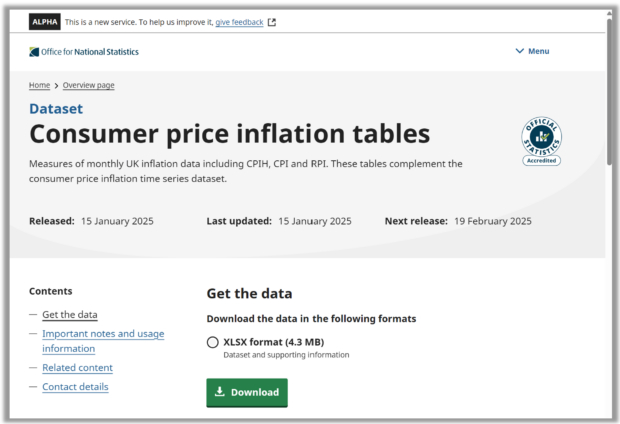
We previously shared the work we’re doing to update and improve the ONS website, and we have recently released a preview of a new page type to give our users a first look at our wider plans for data dissemination.
The dataset overview page
The "Dataset Overview" page does pretty much what it says on the tin. It gives you an overview of a published dataset; collecting everything you need to know about that dataset onto the one page. With each data download, we will also show how it relates to other publications, any limitations on its use and who to speak to should there be any queries.
Every dataset published on our new platform will have one of these pages dynamically generated based on the dataset and its accompanying metadata (which describes the data download). It’s part of our ongoing work to give our users the information they need, when they need it and in the way they want it.
The new design provides a user experience that's consistent with the new website design principles - making our web pages to be easier to use, read and navigate. The new preview can be viewed here, and we’d really appreciate your feedback – just use the link on the page.
Further previews
For this first preview we've chosen to go with a simple example - a single edition of the Consumer Price Inflation tables; with only 1 published version, available in a single format.
Over the coming weeks we’ll share further previews which will include:
- Multiple editions collected into a dataset series
- Multiple versions of a particular edition (e.g. simulating a correction)
- Multiple download formats
These public previews allow us to conduct user research and collect feedback, which we then be use to refine and enhance the pages before they go live.
The new Dataset Overview pages are part of a bigger schedule of work that we refer to as Discoverable Datasets, where we want to make it as easy as possible for data consumers to find and access ONS datasets; whether those consumers are large economic institutions, other government departments, academics or members of the general public.
Improving speed and reliability
Whilst pages like the one we're previewing today are the most visible part of our work, the programme also includes significant behind-the-scenes work to improve the speed and reliability when we publish a dataset. This work is also setting the foundations for a new data dissemination API.
Over time, we'll migrate historic datasets onto the new platform and continue to enhance the capabilities of that API, creating a one-stop-shop for all ONS-published datasets.
If you'd like to support the development of our new services please continue to follow our blog, review our previews and provide feedback. The new preview can be viewed here, and we’d really appreciate your feedback – just use the link on the page.
2 comments
Comment by Tera Allas CBE posted on
It is unclear what this page is trying to demonstrate. The title rather over-promises by stating it is about “How we’re putting everything you need to know about a dataset on one page”. Having reviewed the page, it doesn’t come anywhere close to having “everything one needs to know”. Most importantly, like is the case with most ONS pages, the metadata available on the web page is inadequate. On all ONS pages, the user should be able to see, _before_ and _without_ downloading any spreadsheets, what exact data is included. The metadata should include, but not be limited to: exact measures/metrics provided (e.g., is “output” gross output, GDP, or GVA, and for which period of time, e.g., per month, quarter, year), exact denominator if the metric is a ratio (e.g., what is the denominator for ‘unemployment rate’ or ‘vacancy rate’), base year if the data is an index or expressed in inflation-correct (real, constant year, CVM) terms, frequency of the data (daily, weekly, monthly, quarterly, annual), first and last date for which data is available, geographic coverage (e.g., UK vs. GB), the dimensions of data provided (e.g. geographies, sectors, types of households), the granularity of the data (e.g., how many digits of SIC or SOC or ITL codes), whether any breakdowns are separate or cross-tabs are provided, links to relevant methodology, hierarchies*, and acronyms, and when to expect the next update or release, and – if the latter follows a standard pattern – what that pattern is. * Hierarchies require a special mention, as this is something ONS still does very badly. Many, many, many spreadsheets contain categories and sub-categories without explicitly showing at what level of hierarchy each sub-category sits. To "create" a MECE (mutually exclusive, comprehensively exhaustive) list at the highest level of granularity (i.e., most detailed level), often takes manual effort to figure out which sub-categories add up to which sub-totals, and which sub-categories then add to the "total" total as a whole. If the underlying data is index numbers, it is impossible for the user to do even that, without finding the data for the absolute numbers somewhere else first.
Comment by Martin O'Brian posted on
Many thanks for your comment and feedback Tera. We wanted to show what will be available at the time of launch whilst also sharing that we have plans to locate our dataset information in one place. This initial preview is the first iteration of the project to overhaul what we offer our users via webpages and API, and we’ve focused on basic layout and accessibility to start with. We’ll be adding many more features and functionality over the coming months (including the areas you mention on metadata and data accessibility) and will share further previews ahead of new releases later this year.